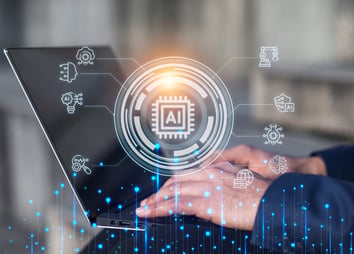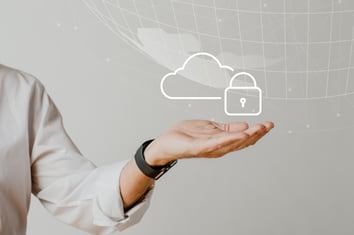However, businesses must also remain vigilant and proactive in fortifying their cybersecurity defenses against evolving cyber threats. That’s why knowing the top seven cybersecurity trends for 2024 can help companies stay ahead of emerging attacks and protect their sensitive data. Looking ahead can help organizations assess potential security risks and update their existing cybersecurity infrastructure to best defend against cyber attacks.
1. AI-Driven Cybersecurity – and Cyber Threats
Artificial intelligence (AI) has become a double-edged sword in the technology world. Generative AI, like ChatGPT, was a defining trend for 2023, and though it will continue to shape the tech industry into 2024, it was used by both sides.
Companies can use AI to strengthen their defense and threat detection capabilities with continuous, automated monitoring. Generative IT and real-time threat analysis can examine a company’s existing policies, regulatory requirements and overall threat landscape to predict high-priority cyber threats and create tailored security policies. AI can enhance software patch management, detect vulnerabilities and recommend how to remediate them with automated incident response systems. In 2024, expect companies to continue integrating AI tools into their existing processes to identify and neutralize cyber threats.
However, AI has also paved the way for a new wave of cyber threats. Generative AI can help create sophisticated and personalized social engineering attacks by creating more believable false information and reducing spelling and grammar mistakes, which are typical qualities of a scam. They can also help hackers impersonate high-level decision-makers and C-level executives, as well as create fake news articles, blogs, social media posts, videos, images and audio clips. Worse, AI can scale threats faster, pushing more attacks into the world.
With this back-and-forth use of AI, companies should expect new regulations and governance around these increasingly complex cyber crimes. They should stay abreast of the evolving compliance requirements in 2024 to avoid legal repercussions and fees, and they must develop internal policies on how AI should be used within the organization. Businesses should roll out training programs on how employees should use AI ethically and keep sensitive data safe.
2. Ransomware and Phishing
As mentioned above, a new era of multi-faceted cyber attacks is coming in 2024, but let’s dive into two specific examples: ransomware and phishing.
Ransomware attacks have been on the rise, causing substantial financial losses and reputational damages. Ransomware is shifting to not only encrypting data for ransom but exfiltrating the data, creating a dual-threat scenario; a ransomware attacker exfiltrates the data to an offsite location and then threatens to leak the data if a second ransom isn’t received.
Phishing is also becoming more sophisticated – gone is the era of misspelled Nigerian prince emails. Cyber criminals create highly detailed and convincing messages using information taken from public websites or social media accounts. These attacks will continue to evolve in sophistication and effectiveness.
In 2024, companies should prioritize building ransomware and phishing resilience by implementing robust data backup and recovery strategies, enhancing employee training programs and deploying advanced threat detection solutions. Traditional practices are becoming outdated, so businesses should evolve their cybersecurity measures to meet the new challenges.
3. Focus on IoT Security
The proliferation of the Internet of Things (IoT) continues, connecting numerous devices while also creating new entry points for cyber attacks due to its interconnected nature. A key focus in 2024 is companies focusing on securing IoT infrastructures with robust security protocols so the data transmitted between devices remains confidential and protected. These can include:
- device authentication
- advanced encryption methods
- regular software updates
- continuous monitoring
- mandatory security certifications for new devices
- integrating AI to monitor unusual patterns
Blockchain technology is also increasingly recognized for its ability to enhance cybersecurity practices. It decentralizes and secures IoT networks by allowing each device to operate as a secure, independent node, making the entire network more resilient to cyber attacks. Blockchain also prevents data tampering, which is crucial for protecting sensitive data.
4. Zero-Trust Architecture
The default traditional approach of trusting all entities within a network is becoming more and more obsolete. Instead, the idea of zero-trust architecture is becoming a fundamental cybersecurity trend.
A zero-trust architecture is when no one is blindly trusted; it operates on the idea of “never trust, always verify.” In other words, no activity can be assumed safe, and verification is required from everyone, regardless of the user, their location or what device they are using. This approach helps defend against internal and external threats by reducing vulnerabilities and enhancing overall security.
To implement a zero-trust architecture, companies should implement a comprehensive approach, including identity authentication and verification, endpoint security, strict access controls and continuous monitoring of network activities.
5. Quantum-Safe Cryptography
With quantum computing on the rise, the need for quantum-safe cryptography is becoming more urgent. Quantum computing has immense processing power that can help strengthen cybersecurity measures and enhance encryption methods, developing more sophisticated algorithms for detecting cyber threats and managing data operations.
In 2024, companies should start implementing cryptographic algorithms that can withstand the computational power of quantum computers. Transition to quantum-safe encryption ensures the long-term security of sensitive data.
6. Adoption of Passwordless Authentication
Companies have started to move to passwordless authentication, especially after Google announced a switch to passkeys. Passwordless authentication includes:
- Passkeys
- Biometrics
- Hardware tokens
- Public-key cryptography
By implementing passwordless authentication, it reduces reliance on traditional passwords and gives individuals great control over their data. Passkeys also remove the need to remember passwords, as you use biometric verification across multiple devices and accounts, which enhances security and simplifies the login process.
7. Cloud Security
Cloud migration has become another integral part of the IT world. However, this means the surface attack area has expanded, and cyber criminals are looking for ways to target hybrid cloud environments and move laterally through cloud environments.
With an increasing reliance on cloud services, secure cloud environments are paramount for businesses. Companies should focus on enhancing cloud security postures and minimizing vulnerabilities so they can protect data and continue business operations.
How Thriveon Can Protect Your Company in 2024
For over 20 years, Thriveon has helped companies in Minnesota andFloridaachieve their goals and keep their data safe with its managed IT, cybersecurity complianceand IT project services. We know the IT world inside and out, staying aware of the newest trends and technologies.
Let Thriveon help your company in the new year and beyond. Schedule a meeting with us today.
